Why Are the Leaves of My Basil Turning Yellow?
go.ncsu.edu/readext?873074
en Español / em Português
El inglés es el idioma de control de esta página. En la medida en que haya algún conflicto entre la traducción al inglés y la traducción, el inglés prevalece.
Al hacer clic en el enlace de traducción se activa un servicio de traducción gratuito para convertir la página al español. Al igual que con cualquier traducción por Internet, la conversión no es sensible al contexto y puede que no traduzca el texto en su significado original. NC State Extension no garantiza la exactitud del texto traducido. Por favor, tenga en cuenta que algunas aplicaciones y/o servicios pueden no funcionar como se espera cuando se traducen.
Português
Inglês é o idioma de controle desta página. Na medida que haja algum conflito entre o texto original em Inglês e a tradução, o Inglês prevalece.
Ao clicar no link de tradução, um serviço gratuito de tradução será ativado para converter a página para o Português. Como em qualquer tradução pela internet, a conversão não é sensivel ao contexto e pode não ocorrer a tradução para o significado orginal. O serviço de Extensão da Carolina do Norte (NC State Extension) não garante a exatidão do texto traduzido. Por favor, observe que algumas funções ou serviços podem não funcionar como esperado após a tradução.
English
English is the controlling language of this page. To the extent there is any conflict between the English text and the translation, English controls.
Clicking on the translation link activates a free translation service to convert the page to Spanish. As with any Internet translation, the conversion is not context-sensitive and may not translate the text to its original meaning. NC State Extension does not guarantee the accuracy of the translated text. Please note that some applications and/or services may not function as expected when translated.
Collapse ▲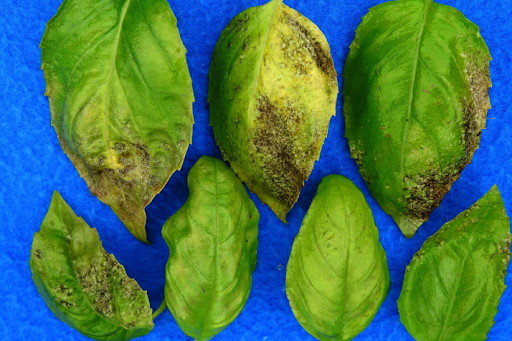
Basil downy mildew symptoms. Photo by Cornell University College of Agriculture and Life Sciences.
Does your basil look more like Big Bird than Kermit the Frog, with mottled, yellowing leaves that eventually turn brown? Basil downy mildew (BDM) is a possible cause of these symptoms, but what can gardeners do to combat this plant disease?
This summer, volunteers with the NC State Extension Master Gardener℠ program are working to answer this question. From the mountains to the coast, Extension Master Gardener volunteers are growing basil plants, monitoring them for signs of BDM, and recording data to determine which varieties stand up best to this destructive disease.
What Is Basil Downy Mildew?
BDM is caused by Peronospora belbahrii, a fungal-like organism that reproduces via spores that travel on the wind. BDM loves warm, humid temperatures, especially warm nights. The spores can’t survive outdoors through winter in states like North Carolina, where temperatures drop below freezing. Instead, BDM spends the winter in frost-free areas along the Gulf Coast. When warm weather begins, spores ride the wind north, infecting basil plants along the way. BDM typically arrives in North Carolina mid to late summer.
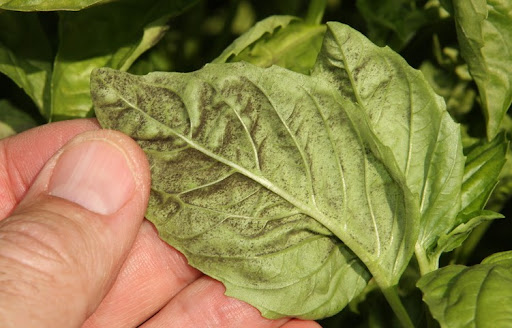
Spores of basil downy mildew on the underside of basil leaves. Photo by Gerald Holmes, Strawberry Center, Cal Poly San Luis Obispo, Bugwood.org
Once a BDM spore lands on a leaf and infects the plant, symptoms appear within ten days. The first sign of infection a gardener will notice is yellowing of the leaves, particularly in the leaf tissue between the veins. While yellowing, known as chlorosis, is also a symptom of nutritional deficiency, a look at the underside of the leaves can help confirm BDM. The presence of purple-brown spores on the bottom of the leaves is a sure sign of infection. Eventually, the yellow parts of the leaves turn brown, ultimately leading to the death of the entire plant.
Unfortunately, there is no easy fix for BDM. There are no products available to home gardeners that successfully control BDM. The good news is that plant breeders have developed new, BDM-resistant varieties of basil. But even among these new varieties, some will be more resistant, vigorous, and most importantly, more delicious than others.
What Are Master Gardener Volunteers Doing In This Trial?
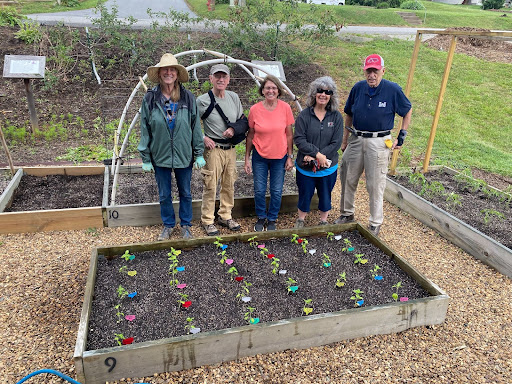
Extension Master Gardener volunteers in Ashe County prepare their basil downy mildew trial. Left to right: Kari Lusk, Bill Naser, Carolyn Jenkins, Catherine Mikkola, and Dick Workman. Photo courtesy of N. C. Cooperative Extension.
To determine which are varieties are most disease resistant and desirable to cooks and gardeners, Master Gardener volunteers have set up basil test plots in their backyard or at their local N.C. Cooperative Extension center to compare five basil varieties bred to be BDM-resistant to the ever-popular yet BDM-susceptible ‘Genovese’ variety. The varieties in the trial are ‘Rutgers Obsession-DMR,’ ‘Rutgers Devotion-DMR,’ ‘Rutgers Thunderstruck-DMR,’ ‘Rutgers Passion-DMR,’ and ‘Prospera.’
Each week throughout the summer, Master Gardener volunteers will examine each plant, note the appearance of BDM symptoms, and rate it from 0 to 3 based on a severity scale. Their work will help determine the best basil varieties to plant in NC.
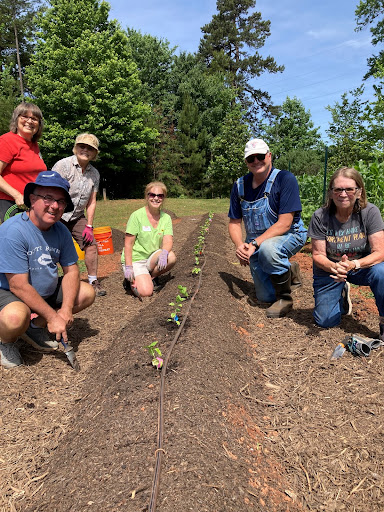
Extension Master Gardener volunteers in Cabarrus County plant basil varieties for the trial. Left to right: Gerri Harris, Bruce Batman, Emily Tate, Sarah Lewis, Mark Robinson, Becky Eudy. Photo courtesy of N. C. Cooperative Extension.
Of course, resistance to BDM is desirable, but most importantly, we want basil to taste good! To gauge the flavor of resistant varieties, volunteers will conduct taste tests comparing BDM -resistant varieties to ‘Genovese’ basil, the culinary favorite. Stay tuned to hear about the taste test trial they will conduct in July.
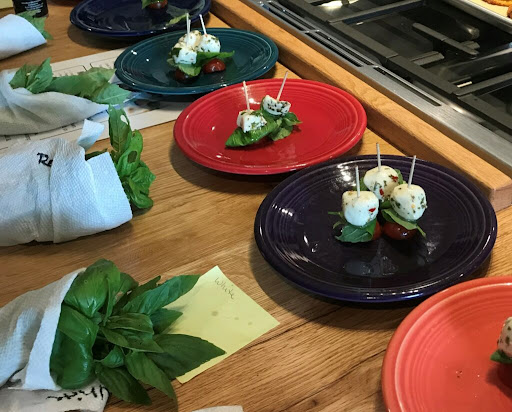
Taste-testing the different varieties of basil will be part of the fun. Photo by Lisa Padgett, Master Gardener volunteer in Chatham County.
Is BDM Here Yet?
Want to see if BDM is in your area? Visit the AgPestMonitor, which tracks BDM throughout the United States. You can sign up for alerts to learn when BDM is reported in your county. Think you might have BDM? Use the Garden Help Directory to find contact information for your local N.C. Cooperative Extension county center.
Stay tuned this summer for more information and photos on how the BDM project is going. Learn more about basil downy mildew from this NC State Extension fact sheet.
We extend a special thanks to Johnny’s Selected Seed for donating seeds of the BDM-resistant varieties for this trial.

Basil downy mildew trial in Carteret County is underway. Photo by Lora Fasolino.
About the NC State Extension Master Gardener Program
Extension Master Gardener volunteers connect people to horticulture through science-based education and outreach that empowers North Carolinians to cultivate healthy plants, landscapes, ecosystems, and communities.
Learn more about how you can be part of the NC State Extension Master Gardener program!


